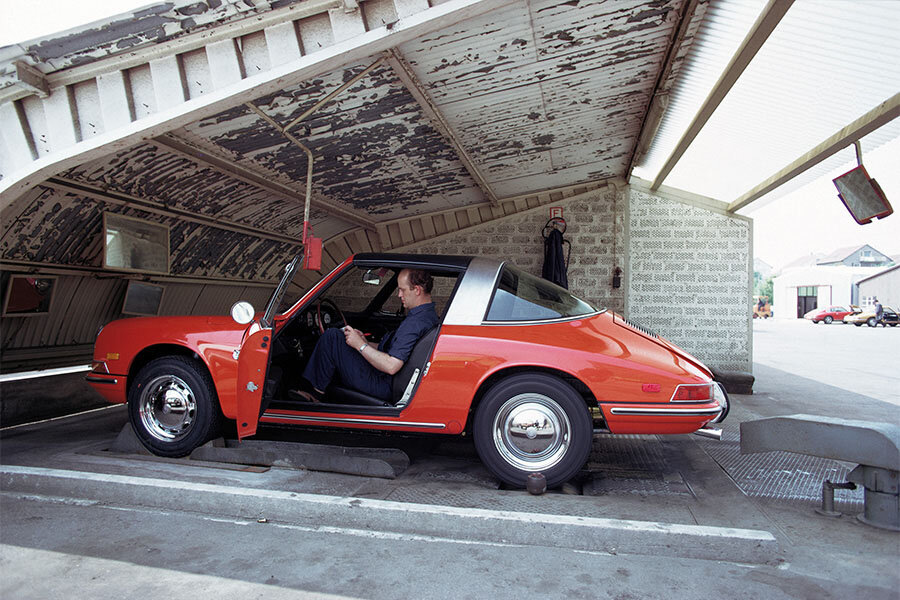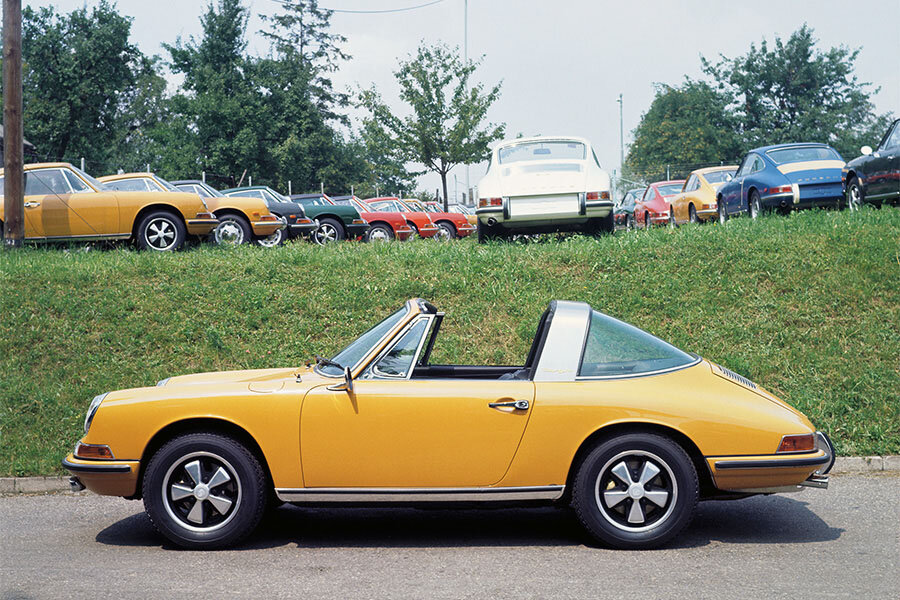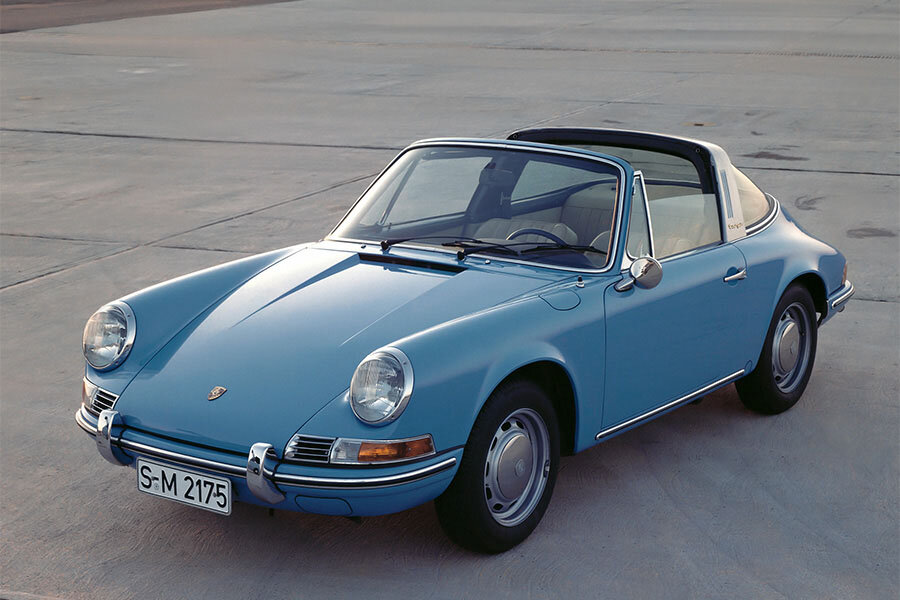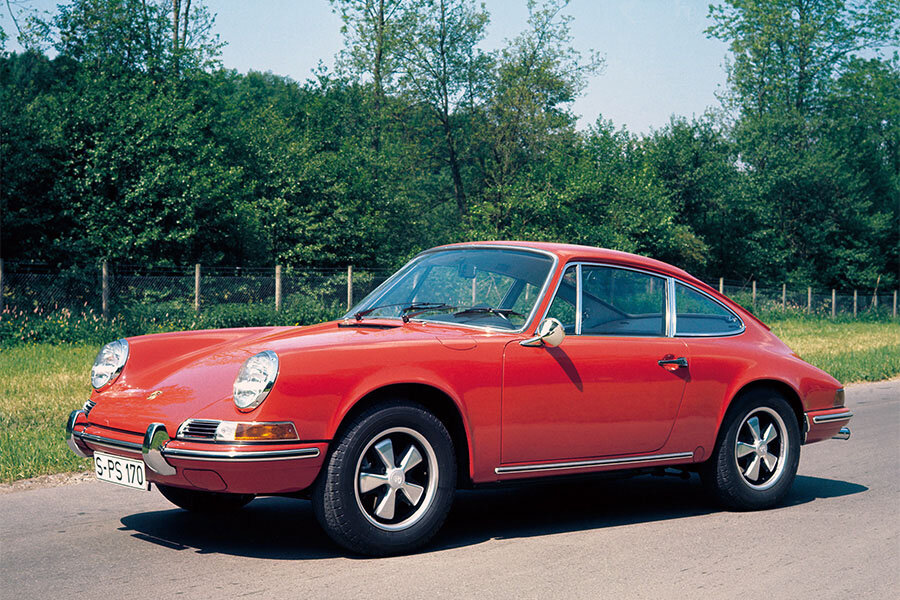Guide: Porsche 911 2.0 A & B-series - a Historical & Technical Appraisal
/BACKGROUND
In its first three years of production, Porsche sold nearly 13,000 examples of their expensive new 911.
The 911 effectively replaced the much-loved 356 and continued Porsche’s inexorable move upmarket; by the mid 1960s, practically any trace of the marque’s humble Volkswagen origins had been erased.
Unlike some other manufacturers that seemed to release new cars every few months, Porsche stuck with their tried-and-tested models and implemented a continual programme of upgrades that kept them ahead of the competition.
In August 1967, the original O-series 911 was replaced by the A-series derivative. Thus began a policy of each model year being given a sequential annual suffix (A-series for the 1968 model year, B series for the 1969 model year and so on).
The 1968 model year A-series 911 was available in four basic varieties: the entry level 911 T, the mid-range ‘normal’ 911, the slightly more luxurious 911 L and the flagship 911 S. All four could be ordered with Coupe or Targa bodywork and with either a manual or semi-automatic gearbox.
Although this seemed a rather complicated line up, it was deemed necessary as two variants (the 911 S and 911 T) did not comply with new US emissions legislation. The 911 L was therefore created as a more upmarket version of the ‘normal’ 911 which otherwise would have been the only variant available in Porsche’s most important market.
CHASSIS
The unitary steel bodyshell shared by all 911 varieties was unchanged in the transition to A-series specification.
Suspension was again fully independent with torsion bars and telescopic shocks fitted all round. The front end used a compact MacPherson strut arrangement with a single lower wishbone while at the rear semi-trailing arms were installed.
The 911 S had a thicker anti-roll bar than the type fitted to the ‘normal’ 911 and 911 L. The 911 T did not come with an anti-roll bar at all.
The big news was a much-improved dual circuit brake system that ran a separate circuit for each axle. As before, disc brakes were fitted to all four wheels. In the case of the 911 S and 911 L, the discs were ventilated.
4.5 x 15-inch ventilated steel wheels were standard on all but the 911 S which came with new 5.5-inch wide forged Fuchs alloys that were optional on the rest of the range.
Under the front hood was a 62-litre fuel tank.
ENGINE / TRANSMISSION
The all-alloy air-cooled Flat 6 engines fitted to A-series 911s were dry-sumped with single overhead camshafts. They displaced 1991cc thanks to a bore and stroke of 80mm and 66mm respectively.
One of the universal changes made was plastic instead of aluminium-backed timing chain guides.
Specifications were as follows:
911 T: Type 901/03, 110bhp at 5800rpm / 156lb-ft at 4200rpm, 8.6:1 compression, two Weber 40 IDT carburettors.
911: Type 901/06, 130bhp at 6100rpm / 176lb-ft at 4200rpm, 9.0:1 compression, two Weber 40 IDA carburettors.
911 L: Type 901/06, 130bhp at 6100rpm / 176lb-ft at 4200rpm, 9.0:1 compression, two Weber 40 IDA carburettors.
911 S: Type 901/02, 160bhp at 6600rpm / 180lb-ft at 5200rpm, 9.8:1 compression, two Weber 40 IDS carburettors.
The ‘normal’ 911 and 911 L destined for the USA came with Type 901/14 engines equipped with exhaust air pumps but published output figures were unaffected.
Unlike the other variants, the 911 T employed milder camshafts and cast-iron cylinder barrels instead of alloy.
The 911 T also came with a four-speed gearbox instead of the five-speed unit fitted to the rest of the range.
In addition to the Type 901 manual gearbox, Porsche introduced a new Sportomatic transmission.
Developed in conjunction with Fichtel & Sachs, the four-speed Sportomatic system enabled manual gear changes without the need for a conventional clutch. Sportomatic cars were equipped with just two pedals and the gearbox worked with a vacuum-controlled clutch that automatically engaged via a touch-sensitive gear lever.
Cars equipped with Sportomatic transmission received engines with special type numbers: Type 901/13 for the 911 T, Type 901/07 for the ‘normal’ 911, Type 901/17 for the 911 L and Type 901/08 for the 911 S.
BODYWORK
A-series 911s could be distinguished from earlier derivatives thanks to their black instead of chrome windscreen wipers, new door handles with recessed push buttons, thicker top and bottom cooling slats on the engine cover and separate instead of adjoined anodised gold Porsche lettering on the engine cover.
Anodised aluminium window frames were fitted instead of chromed brass.
US market derivatives typically came with bumper overriders and thicker headlight shrouds.
INTERIOR
Inside, little was changed from the outgoing O-series derivative. The oval instrument binnacle housed five VDO dials that reduced in size from the central tachometer outwards. To the left were combined gauges for oil pressure / oil temperature and oil level / fuel. To the right was a speedometer and a clock.
The wood-rimmed steering wheel had four distinctive horizontally arced spokes. Various toggle switches were scattered about and a full width wooden fascia was applied to the lower dash section.
Well-padded front seats were upholstered in leatherette with perforated centres. Those in the rear could be folded down to provide additional luggage space.
The ‘normal’ 911 and 911 T were fitted with basic carpeting while the 911 L and 911 S came with high quality velour.
OPTIONS
For the first time, Targas could be specified with a glass rear window instead of the removable plastic screen.
Other options included leather upholstery, front head rests, a rear wiper, an electric sunroof, tinted glass, a supplementary electric heater, a roof rack, spot lights, Koni shock absorbers, chrome-plated wheels, hub caps with a coloured Porsche crest, a choice of Blaupunkt radios and a three-piece fitted luggage set in leather or canvas.
WEIGHT / PERFORMANCE
Coupes typically weighed 1075kg while Targas were 1125kg.
The 911 S had a top speed of 139mph and 0-62mph time of 7.8 seconds. At the other end of the scale, the entry level four-speed 911 T could achieve 129mph and get from 0-62mph in 9.4 seconds.
END OF 1968 MODEL YEAR A-SERIES PRODUCTION
The A-series 911 was discontinued in August 1968 to make way for the 1969 model year B-series variant.
Production totals were as follows:
911 T Coupe: 1611 / 911 T Targa: 521
911 Coupe: 1215 / 911 Targa: 402
911 L Coupe: 1169 / 911 L Targa: 575
911 S Coupe: 1267 / 911 S Targa: 442
1969 MODEL YEAR B-SERIES
B-series 911s most notably featured a wheelbase that was extended by 57mm in an attempt to try and reduce the dramatic oversteer that could be experienced. These new long wheelbase variants were instantly identifiable as each torsion bar cover was now positioned further ahead of the rear wheelarch than before.
Larger rear brake calipers were also fitted.
Underneath the front lid, Porsche reshaped the spare wheel recess, moved the vertical fuse panel to the left front inner wing and switched from a three to four-piece Perlon carpet set.
Die-cast magnesium replaced the sand castings for the crankcase, chain housings and valve covers. An uprated alternator was fitted along with two 12-volt batteries.
New gear ratios were adopted across the board.
Cosmetic changes included subtly flared wheelarches, narrower horn grilles with slightly larger indicators, reflectors next to the rear bumper overriders and bigger Durant wing mirrors. Tinted glass was made standard along with a heated rear window.
Coupes no longer came with opening quarterlights.
Exterior vents were added either side of the roll hoop on Targas.
Cockpits were updated with storage bins under the arm rests, a basket weave dash insert, a patterned gear knob and black instead of beige coat hooks.
The original green on black instruments with chrome bezels were switched to white on black gauges with black bezels.
An improved ventilation system was fitted which comprised a new three-speed fan with heater controls under the dash. A hand throttle was added either side of handbrake.
Porsche also simplified the 911 line up by dropping the ‘normal’ 911 and 911 L in favour of a new mid-range variant: the 911 E.
Significantly, the 911 E (as well as the B-series 911 S) was fitted with Bosch mechanical fuel-injection and CD ignition which meant both variants could be sold in the USA without any compliance modifications.
Specifications were:
911 E: Type 901/09, 140bhp at 6500rpm / 175lb-ft at 4500rpm, 9.1:1 compression, Bosch mechanical fuel-injection.
911 S: Type 901/10, 170bhp at 6800rpm / 183lb-ft at 5500rpm, 9.9:1 compression, Bosch mechanical fuel-injection.
Compression was increased from 9.0 to 9.1:1 on the 911 E and 9.8 to 9.9:1 for the 911 S. Both developed 10bhp more than their predecessors. Peak power respectively came in at 400rpm and 200rpm higher than before.
The engine in the 911 E was identifiable thanks to its distinctive green engine shroud.
Like the outgoing 911 L, the 911 E came with S-type ventilated brake discs. Porsche also added new Boge self-levelling hydro-pneumatic dampers which became an option on the 911 T and 911 S. Customers could specify conventional dampers for the 911 E if they wished.
Both the 911 E and 911 S were fitted with a leather-rimmed steering wheel.
The 911 E came with the 5.5-inch wide Fuchs alloys while the 911 S moved up to 6-inch wide rims (optional on other variants).
The new Type 901/10 engine in the fuel-injected 911 S was further uprated with bigger intake and exhaust valves, a lightweight magnesium engine casing and an external oil radiator in the right-front fender.
The entry level 911 T still ran on Weber carburettors. Output was unchanged and, although the valve springs used by the 911 E and 911 S were adopted, the existing 901/03 engine type number was retained. The US-spec. 911 T engine was given a new type number: 901/16.
5.5-inch wide wheels were now fitted as standard on the 911 T and an optional Comfort package was offered that allowed customers to bring the cockpit up to 911 E specification.
Porsche no longer offered a Sportomatic version of the 911 S. B-series engines equipped with Sportomatic transmission were given the following type numbers: 901/13 (911 T) and 901/11 (911 E).
By this time, the options list had expanded to include the likes of air-conditioning, Recaro sports seats, a limited-slip differential, an outside temperature gauge, luggage straps and an electric antenna for the radio.
END OF 1969 MODEL YEAR B-SERIES PRODUCTION
B-Series production stopped in July 1969 to make way for the C-series 1970 model year 911 which came with a bigger 2.2-litre engine.
Production totals were as follows:
911 T Coupe: 3904 / 911 T Targa: 1282
911 E Coupe: 1968 / 911 E Targa: 858
911 S Coupe: 1492 / 911 S Targa: 614
Text copyright: Supercar Nostalgia
Photo copyright: Porsche - https://www.porsche.com




































